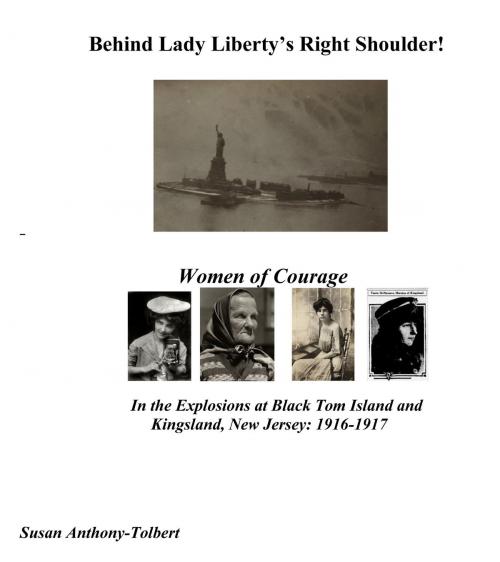Behind Lady Liberty's Right Shoulder! Women of Courage
In the Explosions At Black Tom Island and Kingsland, New Jersey: 1916-1917
Nonfiction, History, Americas, United States, 20th Century| Author: | Susan Anthony-Tolbert | ISBN: | 9781543962147 |
| Publisher: | BookBaby | Publication: | February 1, 2019 |
| Imprint: | BookBaby | Language: | English |
| Author: | Susan Anthony-Tolbert |
| ISBN: | 9781543962147 |
| Publisher: | BookBaby |
| Publication: | February 1, 2019 |
| Imprint: | BookBaby |
| Language: | English |
Before the Oklahoma City Bombing and the Nine-Eleven Twin Towers Attack, there were the Black Tom Island and the Kingsland Explosions of 1916 and 1917 respectively. There were acts of sabotage as well as terror. The Black Tom Explosion has been historically described as one of the worst acts of terrorism on U.S. soil. However, the press and law enforcement of that day initially labeled these explosions as accidents due to the nature of the munitions that were being shipped from Black Tom Terminal and made at the Kingsland plant. Yet, there were some in positions of authority who realized these, like the forty three munition plant explosions that preceded them, were not accidents! Because the U.S. as a neutral power was supplying munitions, food, equipment, and horses to England, France and Russia, Germany was outraged. Germany engaged in acts of sabotage within the United States. Three women, unlikely witnesses to the events at Black Tom, were vital in initiating the investigation and in furthering the investigation into these acts of sabotage. The reader will first meet Anna Rushnak, an aged immigrant to the United States and a woman deeply embedded in her Slovak community in Bayonne, N.J. as well as her spunky young daughter, Lulu Chapman. They faced the awful and awesome tasks of realizing that one of their own relatives (Michael Kristoff) was a saboteur in the Black Tom Explosion and that in good conscience they could not remain silent. It was their report that started the investigation into the possibility of German sabotage. Only a few miles away, but widely separated by culture, by fame, and by circumstance was the young and beautiful, Mena Edwards. She traveled in the highest and most elite German circles in Manhattan. Mena was somewhat famous. She was one of the "Kodak Girls" who were much revered in the early years of the 20th Century. It would take her a few years to report what she knew but once she did, she opened doors for the Mixed Claims Commission attempting to require Germany to make reparations for its acts of sabotage on U.S. soil. Ultimately, the sabotage that occurred would be recognized and more than 50 years later Germany would make restitution. Though there are excellent accounts of the Black Tom Explosion itself and circumstances surrounding it, none emphasize the roles of these three women. It is certainly true that they are mentioned but not enough credit has been given. In terms of the Kingsland Explosion, Tessie McNamara stayed at her switchboard making calls and warning workers until she was almost blown out of her office. Her actions are credited with saving about 1400 workers at the plant. America's "Telephone Girl" did receive adulation at the time but her act of courage must never be forgotten. A new generation of reader needs to consider how she responded. This book is the story of these four women and their acts of courage: acts that differed in how and when they occurred and in the circumstances faced by these women, but courageous nonetheless. This book is the story of these four women and their acts of courage: acts that differed in how and when they occurred and in the circumstances faced by these women, but courageous nonetheless.
Before the Oklahoma City Bombing and the Nine-Eleven Twin Towers Attack, there were the Black Tom Island and the Kingsland Explosions of 1916 and 1917 respectively. There were acts of sabotage as well as terror. The Black Tom Explosion has been historically described as one of the worst acts of terrorism on U.S. soil. However, the press and law enforcement of that day initially labeled these explosions as accidents due to the nature of the munitions that were being shipped from Black Tom Terminal and made at the Kingsland plant. Yet, there were some in positions of authority who realized these, like the forty three munition plant explosions that preceded them, were not accidents! Because the U.S. as a neutral power was supplying munitions, food, equipment, and horses to England, France and Russia, Germany was outraged. Germany engaged in acts of sabotage within the United States. Three women, unlikely witnesses to the events at Black Tom, were vital in initiating the investigation and in furthering the investigation into these acts of sabotage. The reader will first meet Anna Rushnak, an aged immigrant to the United States and a woman deeply embedded in her Slovak community in Bayonne, N.J. as well as her spunky young daughter, Lulu Chapman. They faced the awful and awesome tasks of realizing that one of their own relatives (Michael Kristoff) was a saboteur in the Black Tom Explosion and that in good conscience they could not remain silent. It was their report that started the investigation into the possibility of German sabotage. Only a few miles away, but widely separated by culture, by fame, and by circumstance was the young and beautiful, Mena Edwards. She traveled in the highest and most elite German circles in Manhattan. Mena was somewhat famous. She was one of the "Kodak Girls" who were much revered in the early years of the 20th Century. It would take her a few years to report what she knew but once she did, she opened doors for the Mixed Claims Commission attempting to require Germany to make reparations for its acts of sabotage on U.S. soil. Ultimately, the sabotage that occurred would be recognized and more than 50 years later Germany would make restitution. Though there are excellent accounts of the Black Tom Explosion itself and circumstances surrounding it, none emphasize the roles of these three women. It is certainly true that they are mentioned but not enough credit has been given. In terms of the Kingsland Explosion, Tessie McNamara stayed at her switchboard making calls and warning workers until she was almost blown out of her office. Her actions are credited with saving about 1400 workers at the plant. America's "Telephone Girl" did receive adulation at the time but her act of courage must never be forgotten. A new generation of reader needs to consider how she responded. This book is the story of these four women and their acts of courage: acts that differed in how and when they occurred and in the circumstances faced by these women, but courageous nonetheless. This book is the story of these four women and their acts of courage: acts that differed in how and when they occurred and in the circumstances faced by these women, but courageous nonetheless.















